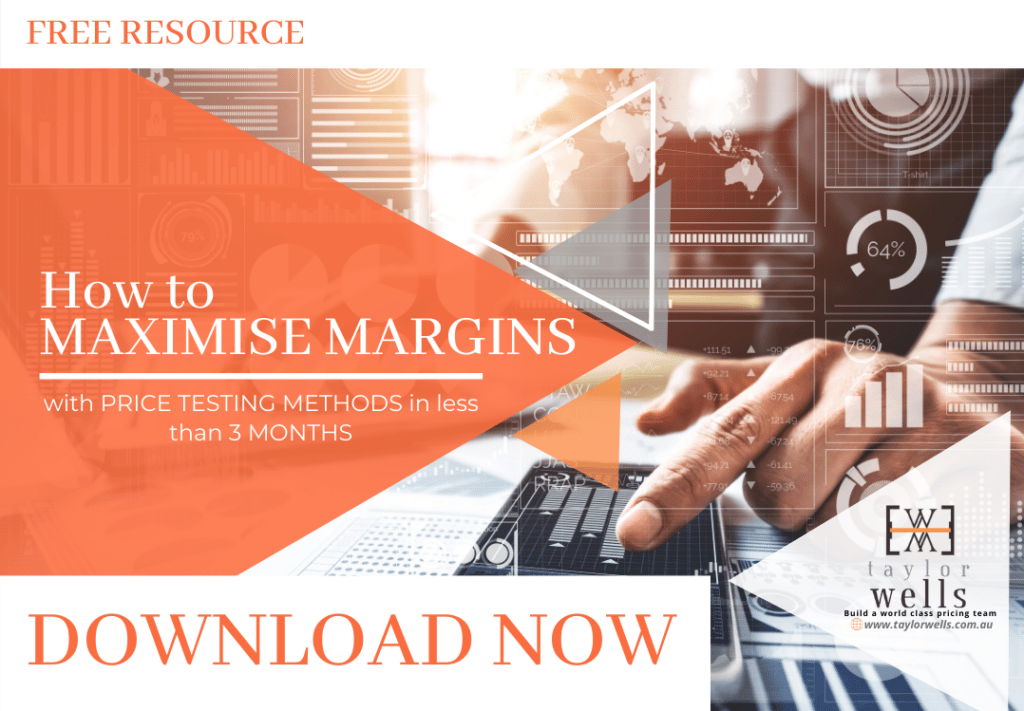
Why Bad Cost Evaluation Messes Up Strategic Pricing For Mid Sized Businesses 💵
Pricing and cost evaluation are major areas to optimise for midsize businesses, compared to small businesses. Smaller companies have a limited number of services or goods. They benefit from material and labour rates that are more stable and predictable, making management easier even with manual measures. But all businesses, regardless of their size, need to understand their costs well enough to price them for profit.
>Download Now: Free PDF How to Maximise Margins
As a company grows in size as well as its range of products and services, it frequently begins to lose revenue stability. They earn more money in some products while earning losses in others. Why does this happen?
Growing companies find it difficult to track all their costs. Oftentimes, there is a lack of realistic forecasts of project and operational cost estimates. As a result, they lose sight of proper pricing for their products.
Another is the failure to identify opportunities for improvement in all aspects of the operations. For some companies, the average profit decreases when the goods and services are rather expensive without justification or transparency with customers. This makes the business will gradually lose patrons, reducing its revenue mix even further.
In all these conflicts, technological advancements can assist enterprises. As a business grows, its cost evaluation and analysis must certainly evolve into an automated system vital to the company’s survival and growth.
In this article, we examine the migration to digital cost evaluation through the lens of an Australian precision tool company. We determine why they undertook the transformation, track their progress, and reflect on the positive results that came from their efforts. Finally, we explain what you should consider if you decide to implement digital cost evaluation into your business.
At Taylor Wells, we believe that efficient and systematic cost evaluation, and proper management and execution, will facilitate a smoother pricing strategy development, and eventually, business expansion.
We also argue that a gradual strategy is essential for success. By the end, you will learn the greatest cost evaluation processes and the best growth approach for scaling your enterprise.
Digital Full Cost Accounting and Evaluation Methods Enhance your Pricing and Growth Strategy
What is cost evaluation?
Cost evaluation is performed by any project or organisation that uses financial or other assets to function. Cost evaluation is the procedure of assessing how resources are used in a broad sense. It can be on any level, from a single task or unit of an organisation to large-scale comparative studies of resource allocation across an entire network of organisations. In essence, cost evaluation is only one component of a larger business cost-benefit analysis evaluation aimed at figuring out if resources are being used efficiently.
Consider time, money, and expertise when determining the resources required to carry out the evaluation effectively. There is no one-size-fits-all cost-evaluation formula. However, there are general methods that can be used effectually.
What are the most common cost evaluation methods?
Cost evaluation methods serve as the foundation for firms to plan how to allocate their resources. It can be of any magnitude, from a specific project or unit of an organisation to large-scale assessments of allocating resources across an entire network of companies.
Manual assessments are not enough to track a greater range of expenditures back to particular products or services as a business grows. Midsize businesses need technologies like:
- ERP (enterprise resource planning)
- MRP (material requirements planning)
- Project management software
It’s worth noting that the analysis and tracking technologies aren’t just for manufacturers. Indeed, the complexity of tracking the exact prices of commodities and services grows rapidly as project numbers increase in expanding midsize organisations. These range from plumbing to consulting to legal firms through merchants and distributors.
In the long term, digital cost evaluation will assist you in developing the finest pricing strategies, which will, of course, make your organisation more successful. All of this helps:
- explore what generates value and at what cost
- trace the flow of labour and materials through the value-generation process
- minimise the costs of excess assets like inventory or underutilised human skills.
Simply having a basic, accounting-focused ERP is unsustainable. Why? Because it leaves many operations unmeasured and unmanaged. While other activities continue to rely on paper-based processes with delayed, periodic reporting at best. This is a defining moment in the digitalisation of midsize businesses. In the parts that follow, we will look at how Australian precision tool companies serve as strong role models from which you can gain helpful insights for your company.
Costs and Prices: From Small to Midsized Business
Decades ago, an Australian precision tool company expanded into a midsize corporation and has maintained its staff of 50–100 people over the years. It discovered while modernising its ERP software, that its earnings by-product was not what was intended. They were much lesser, and one department, Ceramics, appeared to be taking a loss that closed down.
What specifically was the underlying problem? Let’s take a look at the company’s intricate production process. It sells around 5,000 finished components that are assembled from 10,000 parts and subassemblies. The company has significant direct labour costs as well as shifting component costs. These include rare and expensive metals such as gold and molybdenum.
As the sole source for many of its items, the company cannot rely on pricing to the market. Additionally, its small workforce could never utilise spreadsheets to analyse overall production costs to establish prices. Thus, they couldn’t capture the labour expenses on a product-by-product basis since there were simply too many goods and cost components.
The company’s president realised it was hard for them to maintain profitability due to the wide variety of parts and assemblies they sell. They require technological advancement. They needed a company-wide ERP system with MRP capabilities. So, how did the transformation occur?
Investigating the Process of a Digital Full Cost Evaluation and Accounting Methods in a Midsized Company
Midsize businesses nearly never begin from scratch. They have a set of IT systems that served them well when they first came out. Like many enterprises, some businesses originally began with QuickBooks. However, a decade ago, it became clear that these organisations had outgrown it. Most of them switched to MAS 90, a Sage accounting product, in the hopes of better capturing costs for its Ceramics sector. Unfortunately, five years later, such technology was no longer supported, requiring an update to Sage 100.
This allowed participating companies to combine all of their operations into a single networked system. And this is what is commonly referred to as digital transformation which can take years. Trying to squeeze things too quickly frequently backfires, either lasting longer than expected, hurting confidence, or resulting in a complete implementation catastrophe.
Just after the core of the ERP is up and running, the company needs to develop a roadmap outlining the problems the deployment will address. They also need to determine what will be necessary for their future IT projects.
Consider the Ceramics division as an example, which had problematic gross margins. They started the integration by entering handwritten times on travellers into Sage to compute gross margin. But everyone assumed that the Metals division was successful. So, no one paid attention to it. It turned out that there was a great opportunity to learn in the Metals department as well but wasn’t always profitable. That is why, to properly fulfil the transition, you must examine all parts of your firm.
Full Cost Accounting: Digital Cost Evaluation Transformation Methods in Progress
The company finally completed its Sage 100 upgrade, integrated its quality management system, and added work order barcode-scanning technologies towards the end of that year. It also purchased a firm and a division of Jennings Radio, incorporated them into its ERP/MRP and installed a SQL database.
All of this set the course for the next decade of their business – a new CRM for sales versatility and a particular price-quoting module that generated barcoded travelers. They also made an efficient move by adopting a barcode inventory module, which eliminated the year-end inventory treasure hunt. The inventory count took one person only one day to complete, compared to five days and five persons in previous years.
The Positive Outcomes of Full Digital Cost-benefit Evaluation & Analysis of Accounting Methods
The company releases its costs data to support price rises as it’s the sole source of several of its goods. That procedure is possible through systematic cost analysis. The Ceramics division is the sole supplier of one vital military component in Australia. Their customers urged to specify the price at which they would be able to continue production.
The equipment company then used new techniques to demonstrate that the price of that component needs to increase four times. Customers agreed, much to the organisation’s astonishment. The Ceramics section, rather than being shut, is now thriving.
The company noted that using systematic cost analysis technology, they can now correctly calculate and check the gross margin of each of their products. With this data, they may make informed judgments about where to direct capital investments for efficiency and throughput.

Technology investment in cost evaluation pays off. Gross and net margins increase and the books showed this.
Ceramic metallisation, which accounts for 20% of the precision tool company’s revenues, had its gross margin increase by 50%. What’s responsible for these gains?
- Winning supply chain price reductions
- Employing an assembly robot
- Refusing low gross margin orders
- Improving yields
- Lowering QC costs
This all brought in a more efficient foundation and execution of other Six Sigma process improvements. Take note that price increases also play a significant role in a company’s consistent annual growth — up to 40% in four years.
This is why working with a pricing team will always help you get the best outcomes. Our findings show that with the right setup and pricing team in place, incremental earnings gains can begin in as little as 12 weeks. Using superior price management techniques, the team can capture at least 1.0-2.25% more margin after 6 months. After 9-12 months, organisations are frequently generating 3-7% higher profits every year as they find more complex and previously unrealised possibilities, efficiencies, and risks.
For a midsize company, becoming a data-driven organisation is a difficult endeavour. Senior leaders are prone to accepting present systems as adequate, especially if the organisation is achieving solid overall outcomes with them. However, profit is earned or lost one penny at a time. Maintaining contemporary IT systems that are fully able to manage costs is critical to remaining competitive and profitable. The proper attitude is one of constant improvement.
Now, the next stage is to identify a maintenance module that communicates with Sage 100, as well as a custom CRM/sales module for space component assembly. The organisation is getting ready to put in place a demand-planning system. So, how about you? Is your expanding business going to digitise its cost analysis?
Implementing a Digital Full Cost-benefit Analysis & Evaluation on Accounting Methods
After accounting for licences, deployment, training, and productivity loss during the transition, the cost of changing an accounting system can range from hundreds of thousands of dollars to millions of dollars. Selecting the correct cost evaluation or ERP system is critical since so many processes and systems will be placed on top of it, and making modifications or replacing ERP systems afterwards is costly and difficult.
Here are 7 key considerations when selecting an ERP, as exemplified by the company’s success:
1. The ERP software’s potential to scale with your firm. You must anticipate how your needs will change if your firm grows to double or triple its current size.
2. The ERP’s developer company’s long-term sustainability. Small software companies can provide excellent service to specific markets, but a software vendor should be viable and responsive for the next 15 years or more. Check to see if they will be updating the software frequently and whether your upgrade journey will be simple.
3. The cost of running the ERP. Large corporations, such as SAP, will be around for a long time, allow for expansion, and are extremely versatile. However, such systems are frequently expensive to administer and maintain, and they may be excessive for many medium enterprises.
4. The accessibility of ready-made modules that will fit your company. You will almost certainly require CRM, project management, programming, barcoding, MRP, and other services.
5. The ease with which it can be integrated with third-party software. These could include vendor or customer systems, as well as other software systems that you utilise internally.
6. The value-added reseller (VAR) strength. That is the company that sells, instals, and customises software. VARs make a lot of promises; make sure they can keep them.
7. The agreement with the VAR. It should provide incentives that urge it to stay on track.
It is critical to go slowly but surely and take a step-by-step strategy. The reasons behind this are as follows:
1. Medium businesses require reimbursement for the expenditures of implementing IT improvements. Cutting it into little pieces yields immediate effects, enhancing efficiency in one area of the organisation and helping to justify more IT investments. Most businesses cannot afford a massive revamp.
2. Even minor improvements to an IT system are hard. Addressing them in little chunks decreases the likelihood of failure.
3. IT personnel, whether internal or external, are typically resource-constrained. Thus, a sequence of smaller tasks enables a smaller team to be more nimble and to make consistent progress.
4. The necessities of the firm frequently change as it evolves digitally. Most midsize businesses can’t predict what they’ll need until they’ve seen some of the alterations that new systems deliver. The interaction between data-driven system learning and next system design is crucial.
5. Staff who will be working with new technology will have a finite time to learn how to use them. Too much adjustment, too quickly, can impact service levels and revenue-generating operations. Furthermore, any type of change is uncomfortable and must be regulated, which takes time and resources. Technological changes must coexist with other forms of developments, such as new goods, acquisitions, new services, new hires, global growth, shifting market trends, et cetera.
〉〉〉 Get Your FREE Pricing Audit 〉〉〉
Bottomline
It is difficult for midsize businesses to have the capacity to enable systematic cost evaluation. However, if done correctly, it can serve as the foundation for controlling gross margins for both product and service organisations. To a greater extent, the transformation plan should look ahead at least five years, as software selection is frequently driven by what competencies the business will require in the future. A short-term roadmap that describes objectives one to two years ahead of time, on the other hand, is crucial for execution.
For a comprehensive view on building a great pricing team to prevent loss in revenue,
Download a complimentary whitepaper on How to Build Hiring Capability To Get The Best Pricing Team.
Are you a business in need of help to align your pricing strategy, people and operations to deliver an immediate impact on profit?
If so, please call (+61) 2 9000 1115.
You can also email us at team@taylorwells.com.au if you have any further questions.
Make your pricing world class!
Related Posts
Leave a Reply Cancel reply
Categories
- marketing strategy (26)
- Organisational Design (14)
- Podcast (114)
- Pricing Capability (87)
- Pricing Career Advice (10)
- Pricing Recruitment (19)
- Pricing Strategy (292)
- Pricing Team Skills (13)
- Pricing Teams & Culture (25)
- Pricing Transformation (48)
- Revenue Model (25)
- Sales Effectiveness (27)
- Talent Management (7)
- Technical Pricing Skills (35)






